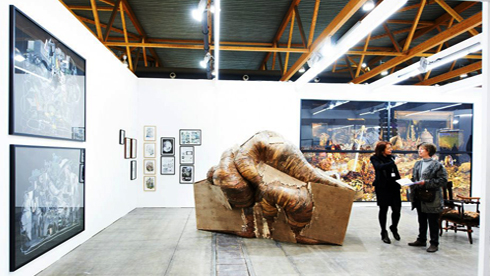Perhaps it is "not quite" the El Dorado for gallery owners, but Frenchman Sébastien Ricou, who as the youngest gallery owner in Brussels, cannot but help grin broadly when talking about his new home town. During his traineeship at the Almine Rech Gallery Ricou realised just how smart it was to move that display space from Paris to the Belgian capital. "In Paris, I would have had half the space for the same money,” he says.
Ricou is not alone in his enthusiasm, with contemporary art galleries popping up throughout Brussels. Add to this trend a new creative director at the Art Brussels contemporary art fair, which will be held this week [from 18 to 21 April], and several smaller art fairs and the Kunstencentrum Wiels performance festival in its slipstream, and it is no surprise that news media such as the New York Times are talking about a “creative renaissance” in Brussels.
More room for experimentation
In 2006, gallery holder Almine Rech, who is married to Picasso’s grandson, moved to Belgium. Nathalie Obadia followed two years later. According to Constance Dumas, director of Obadia’s Gallery, a pied-à-terre in Brussels offers a lot more room for experimentation: "In France it’s difficult to keep a gallery running with artists whose works are not yet so expensive."
Around that period, New York’s Barbara Gladstone established her European head office in the Belgian capital. Pointing in passing to a Sol LeWitt in the garden, Maxime De La Brousse of Gladstone Gallery explains: "Barbara thinks long and hard before opening a gallery. Artists like Anish Kapoor were already represented extensively in London and Paris, that market was saturated.”
The emergence of a number of top galleries in combination with the opening of the Wiels contemporary art centre in 2008 got the ball rolling; all of a sudden, dozens of gallery holders started seeing Brussels as the place to be. Depending on their target audience, they occupied premises around Louizalaan, the Brussels Champs-Elysées with its large fashion houses and ongoing traffic bustle, and around Dansaertstraat, in the midst of boutiques and offices of hip designers and architects.
Belgian collectors’ culture
Especially noticeable is the large number of French galleries, such as Obadia and Rech, but also VidalCuglietta are just a few. Low wealth tax in Belgium has prompted many well-off French people, including Almine Rech, to take up residence on the northern side of the border. Like the other gallery holders she praises the Belgian ‘collection culture’ and the fact that Belgian art collectors remain loyal to their chosen artists, rather than blindly chasing the latest fad.
The first Dutch people to exchange their gallery in Amsterdam for the Dansaert district are Chris Bestebreurtje and Petra Kuipers of Motive Gallery. According to Bestebreurtje, Brussels not only provides access to the attractive Belgian market, but the city is also better situated for international collectors. Especially with the arrival of the high-speed rail link, with has cut the travel time to London, Cologne, Amsterdam to about 2 hours. "We noticed in Amsterdam that we were getting too few International visitors,” he says. "The fact that the 'Stedelijk' Museum, the Rijks Museum and the Appel were closed obviously did not help attract foreign brokers and collectors to the Netherlands.” Bestebreurtje: "And Brussels, unlike Berlin, is a place where a foreign gallery can still easily acquire a share of the market.”
Administrative chaos in Brussels
Does Brussels, however have what it takes to become more than an interim stop for collectors? Can it indeed become a vibrant centre for the non-commercial art scene? "While there are numerous appealing initiatives, there is an urgent need for administrative simplification,” complains the Wiels artistic director Dirk Snauwaert.
He questions the positive attitude of people like Bestebreurtje towards the administrative chaos in the Belgian capital. For instance, the Dutch gallery holder has the impression that permits are more easily acquired that in the Netherlands, which is good for creative initiatives. Snauwaert also sees that more young artists are establishing themselves in Brussels, but thinks that, although cheaper than London or Paris, the Belgian city is still too expensive for those taking their first steps in the world of art.
For that same reason, Sonia Dermience, a Brussels local and member of the non-profit brokers collective Komplot has her doubts about the future of the recently opened galleries. "Berlin is significantly cheaper, the people setting up shop here already have a large start-up capital and wax at length about the 'great Belgian collector', but that would appear to be wishful thinking. The question is whether they will still be here five years from now.”
Was this article useful? If so we are delighted!
It is freely available because we believe that the right to free and independent information is essential for democracy. But this right is not guaranteed forever, and independence comes at a cost. We need your support in order to continue publishing independent, multilingual news for all Europeans.
Discover our subscription offers and their exclusive benefits and become a member of our community now!












